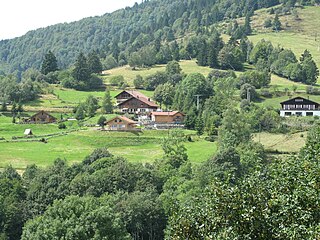
Alsace is a cultural region and a territorial collectivity in eastern France, on the west bank of the upper Rhine next to Germany and Switzerland. In January 2021, it had a population of 1,919,745. Alsatian culture is characterized by a blend of German and French influences.

Bas-Rhin is a département in Alsace which is a part of the Grand Est super-region of France. The name means 'Lower Rhine', referring to its lower altitude among the two French Rhine departments: it is downstream of the Haut-Rhin department. Both belong to the European Upper Rhine region. It is, with the Haut-Rhin, one of the two departments of the traditional Alsace region which until 1871, also included the area now known as the Territoire de Belfort. The more populous and densely populated of the pair, it had 1,152,662 inhabitants in 2021. The prefecture is based in Strasbourg. The INSEE and Post Code is 67.

The Vosges are a range of medium mountains in Eastern France, near its border with Germany. Together with the Palatine Forest to the north on the German side of the border, they form a single geomorphological unit and low mountain range of around 8,000 km2 (3,100 sq mi) in area. It runs in a north-northeast direction from the Burgundian Gate to the Börrstadt Basin, and forms the western boundary of the Upper Rhine Plain.

Odile of Alsace, also known as Odilia and Ottilia, born c. 662 - c. 720 at Mont Sainte-Odile), is a saint venerated in the Catholic Church and the Eastern Orthodox Church. She is a patroness saint of good eyesight and of the region of Alsace.

Munster, Munster-géromé, or (Alsatian) Minschterkaas, is a soft cheese with a strong taste and aroma, made mainly from milk first produced in the Vosges, between the Alsace-Lorraine and Franche-Comté regions in France. The name "Munster" is derived from the Alsace town of Munster, where, among Vosgian abbeys and monasteries, the cheese was conserved and matured in monks' cellars.

Remiremont is a town and commune in the Vosges department, northeastern France, situated in southern Grand Est. The town has been an abbatial centre since the 7th century, is an economic crossroads of the Moselle and Moselotte valleys, and is also a stepping stone for tourists wishing to explore the Vosges and neighbouring Alsace. Remiremont is also known as La Belle des Vosges.

Rosheim is a commune in the Bas-Rhin department in Grand Est in north-eastern France.

Sainte-Marie-aux-Mines is a commune in the Haut-Rhin department and Grand Est region of north-eastern France.

Mont Sainte-Odile Abbey, also known as Hohenburg Abbey, is a nunnery, situated on Mont Sainte-Odile, one of the most famous peaks of the Vosges mountain range in the French region of Alsace.

Andlau is a commune in the Bas-Rhin department in Alsace, Grand Est region of northeastern France.

Barr is a commune in the Bas-Rhin department in the Alsace region of north-eastern France.

Gertwiller is a commune in the Bas-Rhin department in Alsace in north-eastern France.

Fouday is a commune in the Bas-Rhin department in Grand Est in north-eastern France.

The Taennchel is one of the summits of the Vosges Mountains, rising to 988 metres (3,241 ft). The Taennchel rises at the East of France, in the département of Haut-Rhin, halfway between Strasbourg to the North and Mulhouse to the South, around 60 km (40 mi) from both cities.

Neubourg Abbey is a former Cistercian monastery in Alsace, France, in Dauendorf, about 9 km west of Haguenau in the Bas-Rhin department.

The Church of Saint Faith of Sélestat is a major Romanesque architecture landmark in Sélestat along the Route Romane d'Alsace in the East of France. The church having been built over a very short time span, it appears strikingly homogenous in style and proportions, however some parts have been completed and others modified in a Romanesque Revival style by the architect Charles Winckler between 1889 and 1893. During that restoration campaign, a crypt dating back to around 1085 was discovered and made accessible as well. Like many major buildings in Alsace the church is made of pink Vosges mountains sandstone.

The Château de Dreistein is a ruined castle in the commune of Ottrott in the Bas-Rhin département of France. It is, in fact, three separate castles built on rocky promontories, hence the name drei Stein, "three stones" in medieval German.

The Château du Hagelschloss is a ruined castle in the commune of Ottrott in the Bas-Rhin département of France. It was constructed in the 13th century.

Niedermunster Abbey, situated at the foot of Mount Saint Odile at an altitude of 511 metres, was founded around 700 A.D. to cater for the overflow of pilgrims to the Saint Odile Abbey, formerly known as the Hohenbourg.

Eugénie of Alsace, was the second abbess of the Hohenburg Abbey, in Alsace, France, from 721 to 735. She was later made a Roman Catholic saint. She was a niece of Saint Odile and sister of Saint Attalus. Saint Eugénie's feast day is celebrated on 16 September, which was the day she died of natural causes in 735 in Hohenburg.


























